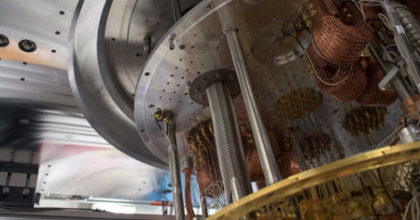
 )
)Maybe “review” is overly generous, and it’s not like anyone is on the edge of their seat for my opinion of a 13-year-old book; still, I wanted to bring up a few ideas from the book for discussion. Programming the Universe is Seth Lloyd’s introduction to quantum computing. After a primer on information theory–one of the mathematical foundations of computing–and the inner working of classical computers (like the one I’m typing on and the one you’re reading on), Lloyd explores two main topics. The first is how quantum computers differ from classical computers. The second describes the universe as a quantum computer and all physical interactions as computation. Although I may not be exactly representative of a layperson, at least on the computing side, I found the book accessible and Lloyd’s approach to framing the topics insightful. I definitely learned some new things about quantum computing, and even the more familiar topics still came with some fresh perspective.
Although Lloyd was not overtly concerned with any religious intersections, I found the discussion of the universe as a quantum computer relevant to a couple of issues that come up in science & faith conversations. The idea that our universe is just a simulation is popular in some quarters, inspired by the physics of holograms or the exponential growth of (classical) computing power. It’s a curious idea, in that it is both at odds with a traditional Christian understanding of the world and its creation while simultaneously invoking a lot of language about creators and higher intelligence and design more typical of religious creation accounts. In Lloyd’s telling, the universe is essentially indistinguishable from a quantum computer simulation of the universe. Yet such a simulation requires the entire universe to run. I took that to mean that you’d basically have to create the universe to run a simulation of the universe. So if we are living in a simulation within an even more complex world populated by a being or beings capable of actually creating our universe, we’re talking about something and someone so far beyond our experience that we might as well be talking about God.
The other discussion of interest revisited everyone’s favorite metaphor, monkeys banging on typewriters. Mathematically, if you give enough monkeys enough time with their Remingtons, they’ll type you any book you want–just be prepared that “enough” may mean “infinite.” You will also have to sift through reams and reams of gibberish to find Ulysses or Twilight or what have you. Even more frustrating, you’ll also have to deal with a multitude of near misses, oceans of “Stately, plump Buck Mulligan”s that carry on in groundbreaking stream of consciousness for a while before devolving into a stream of nonsense, and not a single one of them will provide a clue where to find that final “Yes.” So are those hunting-and-pecking simians a useful metaphor for the creation of the cosmos or the evolution of the species? Because the universe is a computer, Lloyd says ‘no’ and suggests we instead imagine monkeys with Macs, not Underwoods. Typewriters only deal with data, while computers also deal with programs that process, transform and interpret it. To get complex data out of a typewriter, you need to put complex data in. But computers can output complex data from simple programs. And simple programs don’t take nearly as many monkeys or as much time to find, even just banging away at random. By itself, this tweaked version of the metaphor doesn’t give us all the answers about where the universe came from or what purpose it might have. But it does gives us a new way to phrase our questions.
Andy has worn many hats in his life. He knows this is a dreadfully clichéd notion, but since it is also literally true he uses it anyway. Among his current metaphorical hats: husband of one wife, father of two teenagers, reader of science fiction and science fact, enthusiast of contemporary symphonic music, and chief science officer. Previous metaphorical hats include: comp bio postdoc, molecular biology grad student, InterVarsity chapter president (that one came with a literal hat), music store clerk, house painter, and mosquito trapper. Among his more unique literal hats: British bobby, captain’s hats (of varying levels of authenticity) of several specific vessels, a deerstalker from 221B Baker St, and a railroad engineer’s cap. His monthly Science in Review is drawn from his weekly Science Corner posts — Wednesdays, 8am (Eastern) on the Emerging Scholars Network Blog. His book Faith across the Multiverse is available from Hendrickson.

Leave a Reply